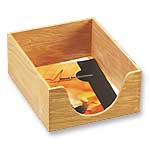

IOTray creates a set of virtual in and out trays, like the ones you might find on your desk. These trays are accessible through the web. A tray owner can deposit files in his or her tray, then tell other people to pick up the file "in my out tray". You can also drop off files in other people's trays.
IOTray is written in Apache::ASP under Linux, and is released under the terms of the GNU General Public License.
Screenshots:
Here are some screenshots showing IOTray in operation.
General usage:
File access:
When you drop off a file in someone else's tray, the file will
only be visible to you and the tray's owner. If you drop off a file
in your own tray, the file is by default available to everyone.
If you wish to limit access to files you've dropped into your tray,
you can do this by using the ``Change Recipient'' button at
the bottom of your tray.
Files may not be overwritten. Only the owner of a tray may replace a file with another of the same name, and then only by first deleting the old version of the file before dropping off the new version.
Deleting Files:
You may selectively delete files in your own tray. You cannot
delete files in the trays of other users (except the ``Free For All''
tray -- see below).
Moving Around:
Once you've logged in to IOTray, you'll see a banner at the
top of the page, showing your name on the left, and one or more
buttons at the right. The buttons are:
 |
Log Out | Log out of IOTray. All users will see this button. |
 |
Show All Trays | Show an index of users who have trays. Only non-anonymous users will see this button. |
 |
Show My Tray | Go to your own tray. You'll only see this button if you have a tray of your own. |
 |
Help | Display this page, with information about IOTray. |
Help:
At the bottom of each tray you'll see some helpful hints about using
IOTray.
Record-keeping:
Whenever someone drops off a file in your tray, you'll be sent an e-mail
telling you about it. This e-mail will contain the address of your
tray, for convenience. If you go to the address displayed in the e-mail,
you will see your tray, and the file you've just deposited will appear
highlighted.
All transactions that take place in your tray will be recorded in a log file. You can look at this log file by clicking on the ``Show Log'' icon at the bottom of your tray.
Anonymous usage:
Users without accounts may log in as 'anonymous', using their e-mail address as password. These users will appear in the activity logs as 'user@email from x.x.x.x', where x.x.x.x is the IP address of the client machine. Anonymous users operate under some restrictions:
The "Free For All" (everybody) tray:
Anyone may deposit files in the "Free For All" tray. Files deposited here are available to everyone. The restrictions on anonymous users, described above, still apply though. Users may delete files in the "Free For All" directory that were deposited by the same user.